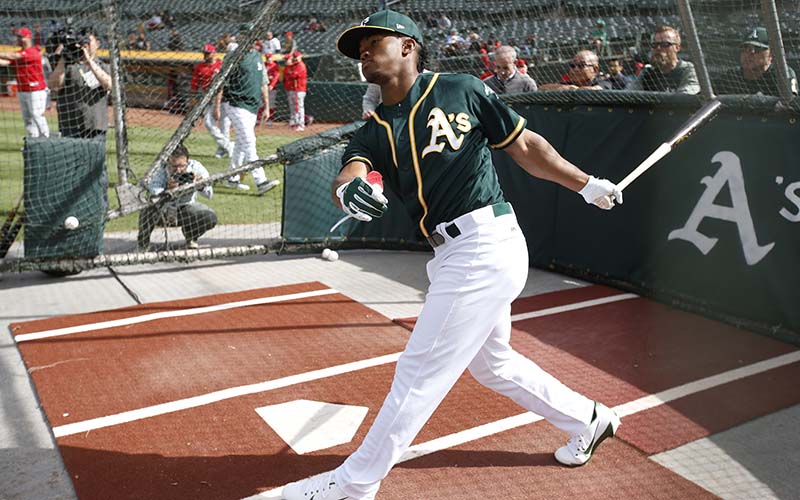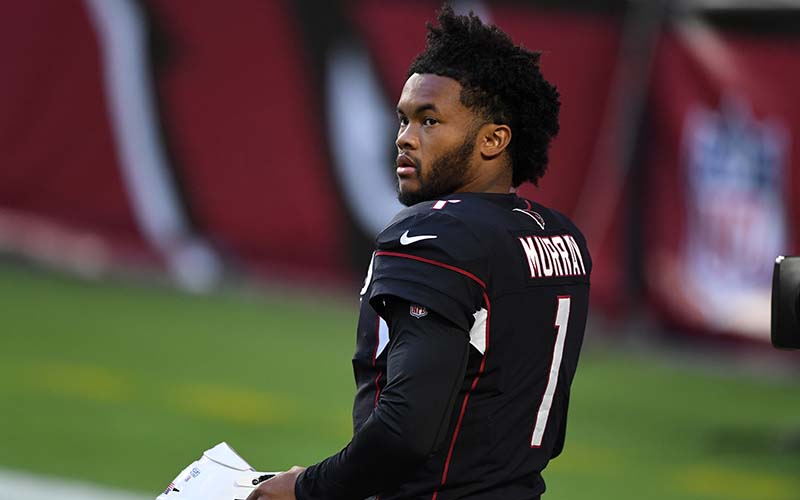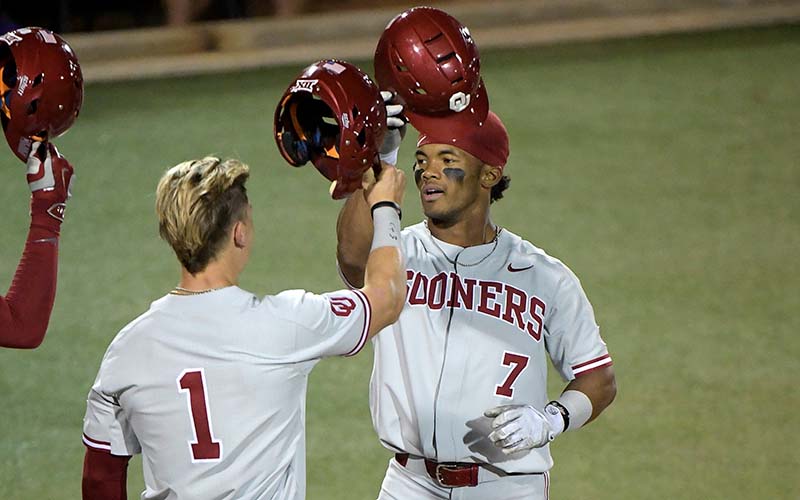
Murray’s skills on the diamond led him to be selected ninth overall by the Oakland A’s in 2018. (Photo by Michael Zagaris/Oakland Athletics/Getty Images)
PHOENIX – It didn’t take long for the football star Kyler Murray to impress major league baseball scout Chris Reilly.
Reilly had heard of the shine that Murray, a two-sport phenom at Oklahoma, brought to a baseball diamond, but he had never seen him play until he scouted one of Murray’s games early in the 2017 season shortly after he was hired by the Oakland Athletics.
Leading off in the Sooners’ second game of a doubleheader against Villanova, Murray reached base on an infield single. And then, in the span of one at-bat, he stole second and third. Murray went on to score on an RBI groundout.
Reilly couldn’t believe what he saw. Ten pitches were thrown between when Murray arrived at first and crossed home plate.
“I was like, ‘Holy cow, this dude flies!’” Reilly said. “That is the excitement that I had heard about.”
At the time, Murray was just getting his feet wet in college baseball after not playing for two years. He was fighting to adjust to a different flow than the high school game. But his raw abilities were already there, and anyone who saw him play could tell it was only a matter of time before he became a key contributor.
“He didn’t come off as crude as a baseball player,” Reilly said. “He just looked rusty.”
The same qualities that propelled Murray to the Heisman Trophy in 2018 when he became the second straight winner from Oklahoma after Baker Mayfield – and to the elite class of NFL quarterbacks as an Arizona Cardinal – were obvious on the diamond to Reilly, who said, “He’s got a tremendous set of skills paired with his athleticism, which made him unique.”
Murray decided to forgo a career in baseball to pursue greatness in the NFL after he was drafted No. 1 overall in 2019, and his success so far with the Cardinals has seemed to validate his decision.
But Murray has been an enigma recently. His standing with the organization and his overall character have been called into question, prompting Murray to wipe his social media clean of any Cardinals references and some fans to speculate about his possible return to baseball.

Murray became the only athlete ever to be selected top 10 in two major drafts after the Cardinals signed him with the no. 1 overall pick in 2019. (Photo by Norm Hall/Getty Images)
He’s unlikely to change career paths any time soon – or follow the lead of another former Heisman Trophy winner Bo Jackson or Pro Football Hall of Fame member Deion Sanders in playing simultaneously in the NFL and MLB. But for nearly two years – from 2017 through 2018 – Murray was that rare collegiate performer who showed abundant promise in football and baseball, and appeared to love both equally, leading scouts like Reilly to ask him in all seriousness if he’d give up an almost certain NFL career for a shot at the majors in baseball.
“He said, ‘Yeah, I would do it,’ Reilly said. “Nobody knew that he was going to sit behind the Heisman Trophy winner and be better than him.”
Based in part on Reilly’s reports, the A’s would select Murray ninth overall in the 2018 MLB draft. He is the only collegiate athlete taken in the first 10 picks in two major sports drafts.
Under former Sooners baseball coach Pete Hughes, Murray didn’t give off the perception that he was partial to football over baseball or vice versa. What stood out most was his everlasting drive to compete.
“The only thing I saw from Kyler was one-hundred-percent buy-in,” said Hughes, who played football and baseball at Davidson (NC) College, giving him some idea of the challenges Murray faced.
“It was tough for me to do that, never mind Kyler doing it at OU running around at the highest level,” Hughes said. “It wasn’t for show. If it was, he wouldn’t have gotten drafted as high as he did.”
Hughes coached Murray only one season, in 2017, but Murray left a lasting impression on him from the beginning. Hughes initially didn’t know that Murray wanted to play baseball at OU upon his arrival from Texas A&M, where he appeared in eight football games as a freshman in 2015 before transferring the following year to Oklahoma.
“I didn’t even know if baseball was a part of the equation,” Hughes said. “Kyler wanted to play and he was all-in from the start; on our team and our goals. Here’s a guy who was behind a future Heisman Trophy winner and those days around football were critical for Kyler. He made the time to do both. I respect the effort and the commitment he put in.”
Bouncing back and from between spring football and baseball, Murray played only 27 games in 2017. In 49 at-bats, he hit .122 with 20 strikeouts and 13 walks.
The rust was still there after two years away from the sport. As the season wore on, Murray saw his role go from platoon outfielder to pinch runner. It didn’t help that he was trying to produce on the diamond while simultaneously learning the nuances of Lincoln Riley’s offense behind Mayfield, but he still made an impact.
Murray’s sharpest tool in baseball was his speed, which is why the role switch gave Hughes an extra-special weapon to deploy in critical situations. In 13 steal attempts, Murray was successful 12 times, mostly, according to Hughes, in high-leverage situations.
“His role went from playing every day to, ‘Hey Kyler, it’s the ninth inning in a tie game. I need you to steal second base when everybody in the world knows you’re gonna steal second base,’” Hughes said. “They pitched out, slide-stepped and it didn’t matter. He stole all of them in critical situations. That’s how awesome that kid was as an athlete.”
When Hughes watched Murray on the basepaths, he was reminded of the Washington Nationals’ Trea Turner, a former North Carolina State standout who is considered one of the fastest runners in major league baseball.
“It’s just different speed on a diamond where it’s like, ‘Oh my goodness,’” Hughes said.
Murray’s trademark speed and willingness to get better prompted Hughes to send him to the Cape Cod Baseball League – a collegiate summer baseball circuit – to play for the Harwich Mariners, coached by Hughes’ longtime friend Steve Englert. Murray signed a temporary contract to play among the nation’s best before he had to return to Norman for football camp.
“I worked with Pete for years and I value his opinion and evaluation,” Englert said. “His numbers weren’t Cape-worthy but I trusted Pete. He said he just needed some at-bats to bump the rust off.”
Englert soon realized the hype was warranted. It’s not often that a player like Murray – who barely played that spring – goes to play on the Cape, but his special talents helped him fit in right away.
“You could just tell right away how much athleticism the kid had,” Englert said. “On the bases he was ridiculous. He could steal a bag and wouldn’t even have to get a lead. He used his time to really develop.”
Murray produced a .170 average in 47 at-bats, but continued to show flashes of raw potential on the bases and at the plate. After going hitless through his first six at-bats, Murray walloped his first collegiate home run against the Bourne Braves.
Two days later, Murray tallied his first multi-hit game against the Orleans Firebirds, and repeated the feat against the Cotuit Kettleers a few days after that. He contributed four stolen bases before returning to Norman in early July.
In Englert’s mind, it was time well spent, as evidenced by the attention Murray drew from scouts.
“He was a nine hitter for us early on and he was hitting in the middle of the lineup for us by the time he left,” Englert said. “You could see the adjustments he made and how he progressed in such a short time…Very rarely does that happen.

In 2018, Murray saw his power numbers climb significantly, finishing with a slugging percentage of .556 paired with 10 home runs.
(Photo by Max Faulkner/Fort Worth Star-Telegram/Tribune News Service via Getty Images)
“Playing every day on the Cape against that caliber of competition – you can hit .120 – you’re still gonna get better. I think when he proved himself against the best he opened up some eyes.”
After 16 games on the Cape, Murray was primed for a breakout year the following spring under the Sooners’ Skip Johnson, who was promoted to head coach earlier that summer.
In 2018, Murray adopted a leg kick and made minor mechanical adjustments to his swing to improve his pitch tracking and tap into power he didn’t previously have.
Johnson recognized his progress and beginning that March, he put Murray in the cleanup spot in the batting order and played him regularly in center field. Murray started to show bursts of a power-and-speed combination that is rare among players today.
In the weekend opener against Texas A&M Corpus Christi, Murray belted a grand slam to give the Sooners the lead for good on his way to a six RBI series.
He was starting to draw more walks, too. By the end of the season, he reached base 28 additional times via the free pass. He also stole 10 bases in 14 attempts while putting less of an emphasis on his speed and more on his run-producing capabilities.
“He improved a lot,” said Steele Walker, Murray’s former teammate at OU. “The more reps he got he got better. It wasn’t anything that was amazing, but what was impressive was how he progressed from his sophomore year through his junior year where he started to actually hit home runs. If you hit some homers and people see that you’re fast, all it takes is a team to take a risk on you.”
It became clear that Murray had first-round talent. As the weeks went by more and more eyes were on him. One of those who spent a lot of time watching Murray was Reilly. With each passing day the A’s moved one step closer to drafting what Reilly described as a “generational-type athlete” in Murray.
“His pitch recognition skills from logging those at-bats to the 2018 season improved,” Reilly said. “You could really see him start to take pitches better. He was seeing it a lot clearer out of the hand.”
As the season progressed, Murray had breakout weekends against Baylor, where he went 5-for-11 in the series with two stolen bases, and TCU, where he belted two home runs in the series opener. Murray finished the 2018 season with 189 at-bats across 51 games. In that span he hit .296/.398/.556, good for a .954 OPS.
He had 10 home runs, which was second on the team to Walker’s 13, to go with 13 doubles and three triples.
“It was a solid year at the right time,” Walker said. “I think he was proud of how he played.”
After another spring of juggling football practices and baseball, Murray headed into what would be an historic season as a first-time starter at quarterback. Walker, who has known and watched Murray dominate on the football field since high school, wasn’t surprised.
“He told me our sophomore year, ‘If I get a chance to play next year, I’m gonna win the Heisman,’” Walker said. “And he did it. I didn’t doubt it because I watched him do it for three years in high school.”
Murray threw for 4,361 yards, rushed for 1,001 yards and amassed 54 total touchdowns en route to winning the Heisman. At that point, Murray’s career on the diamond was all but over.
There’s always room to wonder what he could’ve done had he stayed committed to the A’s, who permitted him to return to Norman to play football that fall. Now, all that’s left to ponder is whether Murray could do both professionally while remaining healthy.
Englert, who happened to be in Nashville to watch Murray get drafted by Arizona in 2019, knows that he certainly has the potential to juggle both sports once again.
“Scouts would ask me, ‘Is he gonna play football or baseball?’” Englert said. “I said, ‘He can pick whatever he wants. It’s up to him. I think he’s gonna be good either way.’ Obviously he got drafted in the first round and he did his thing in football. I bet if he wanted to get back into baseball it wouldn’t take him too much time to get back into the swing of things.”
Reilly, who is now a scout with the Boston Red Sox, refused to rule out Murray returning to baseball.
“I think when his NFL career first started I was optimistic that there would be an opportunity to do both,” Reilly said. “It’s just an ongoing curiosity of what could’ve been had he chosen baseball. I would never bet against him.”
There’s no hesitation from Hughes on the matter.
“One-hundred percent,” Hughes said. “It wouldn’t be long before he’d be a big leaguer. Everyone laughed at Deion and said he couldn’t do it and he did. Kyler is the same way, he’s one of if not the best athlete on the planet.”
The bottom line is Murray doesn’t have to prove whether or not he can play the game at a high level, he’s already done that. But much like Jameis Winston and Russell Wilson, two other NFL quarterbacks who played collegiate baseball, Murray has narrowed down what he’s best at, and he’s sticking to it.

